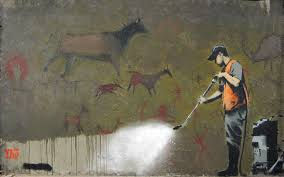Final Exam Steps: Three Media & Blogpost!
- Big Nerd

- Apr 13, 2020
- 2 min read
Updated: Apr 29
Here we are, my Nerdlings! All ready to button up the year. For this last assignment, you will practice some 21st century writing. Let's "Postmodernize" a work from one of the Literary Traditions we've studied this year!

That means, DIGITAL PUBLISHING.
How do you "POSTMODERNIZE" your selected Literary Tradition source if it is Anglo-Saxon literature & Beowulf? or if it is Romantic Literature & Frankenstein? or if it is Medieval literature & Canterbury Tales?
Find quotes from your source that embody the literary tradition they are from.
Name the elements the quotes represent, & L2 analyze them.
Describe how the meaning, effect, and purpose could be transformed - "Postmodernized" - by analyzing the original traits through the lens of Postmodern qualities. Check out Ima Nerd's model for some inspiration.
Using your Literary Tradition source and details from your 3 posts, go to the Forum (at the bottom of the Home page) to write a blog post for your Final Exam.
It's an argument about the three works you selected for commenting here, your evidence from your Literary Tradition source, and your content from external sources.
You may want to compose on a Google doc to spell-check, etc. Be aware: if you produce your post on a Google doc, you might have to re-link and reload images & stuff to publish it as a blog post on the Forum.
After you publish on the Forum, upload your complete blogpost to Canvas in the "Final Exam Submission Container." This is where Big Nerd will score and award you credit.
To Submit this work on Canvas, you have TWO upload options:
1. Upload a Google Doc to Canvas with all digital media intact, then
2. Directly link to your blogpost here in the Forum to Canvas (click the snowman on this site & "share post" for a live link).
Now for the Final Exam Info:
Compose a blog post analysis (in the Forum) of Postmodernism using your three selections...
For detailed instructions, click on the Printarius image. Otherwise, begin blogging by clicking the light red button beneath the floating corgi: "Create New Post."
Want some guidance organizing your blogpost into a coherent argument? Check out Ima Nerd's Model-Template:



Bubbles
5th Period
Summary of the canterbury tales
The Canterbury Tales is a group of stories written by Geoffrey Chaucer in the late 1300s. The main idea is that about 30 people are going on a trip together from London to Canterbury to visit the shrine of Saint Thomas Becket. To make the journey more fun, they decide to tell stories along the way. Chaucer uses this setup to share many different kinds of stories.
Each person tells a story that shows something about who they are. For example, a knight tells a
serious story about honor and love, while a miller tells a funny and rude story about tricking people. Some stories teach lessons, some are about animals, and others…
Phineas
5th Period
Final Exam Blog
Postmodernism 101: Weaving It ALL through the stitches of the Creature!
Introduction of Frankenstein
Mary Shelley’s Frankenstein, even though it was written during the Romantic period, shows many ideas that connect to postmodernism. The story is told through letters and different points of view, which makes the truth feel uncertain and complicated. This use of fragmentation shows how reality can be broken into many pieces. Shelley also includes intertextuality, by referencing other books and ideas, and turns the story itself into a kind of poioumenon a story about making stories through Victor’s act of creating the monster. Instead of giving us clear answers, Shelley uses these postmodern ideas to make us think about big…
YHWH Lover- 5th
Frankenstein, or, The Modern Prometheus : the 1818 Text. Internet Archive, 2013/archive.org/details/Frankenstein1818Edition/Frankenstein
Frankenstein by Mary Shelley is about Victor Frankenstein, a young scientist who becomes obsessed with creating life. He builds a creature from dead body parts and brings it to life, but is horrified by how it looks and runs away. The creature is left alone and rejected by everyone, even though he just wants love and connection. As he learns about the world, the creature becomes angry and hurt, eventually turning to revenge by hurting Victor’s loved ones.
The story explores big ideas like the dangers of trying to control nature and how people need to be accepted. It also shows postmodern themes, like fragmentation—Victor…
Officer Redneck
5th Period
From Manners to Postmodern
Introduction
Emily Brontë’s Wuthering Heights is rooted in the Victorian tradition, exploring themes like class, morality, and intense emotion through a dark, gothic lens. Yet the novel also anticipates Postmodern ideas. Its layered, unreliable narration draws on metafiction, while the blurred identities and haunting repetitions suggest a simulacrum which is a world where reality is unstable and characters become echoes of each other. Through its contradictions and refusal to offer clear meaning, the novel deconstructs traditional thoughts like love and hate, civilization and savagery. Though Victorian in form, Wuthering Heights reaches forward, hinting at a world where truth is fragmented and endlessly questioned.
Summary of Element One - Deconstruction
Links to Postmodernism in Your…
Betty Boop
5th Period
Final Exam Blogpost
Knights, Nostalgia, and Noise: Reforging Le Morte d’Arthur in the Age of Postmodern Collapse
The End of the Age of Heroes
Sir Thomas Malory’s Le Morte d’Arthur once stood as a solemn monument to chivalry, order, and the tragic fall of idealism. But viewed through the fragmented lens of Postmodernism – a worldview shaped by irony, pastiche, and meaning-making amid chaos – this legendary epic begins to glitch. It no longer reads as a coherent moral epic, but as a commentary on the disintegration of narrative certainty, the instability of identity, and the failure of grand ideological structures. Knights no longer uphold truth; they become avatars of performance. Honor is hollowed out, stories recycle themselves,…